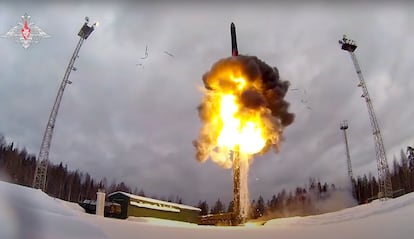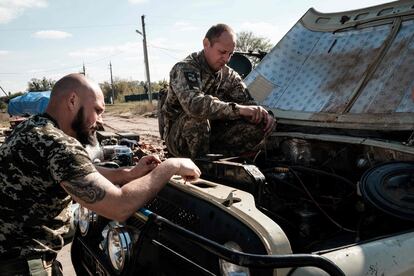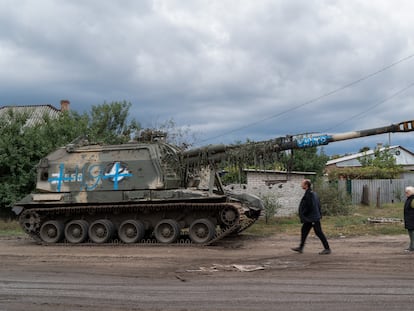Putin’s nuclear threats: Should the West take them seriously?
As the Ukrainian counteroffensive gains ground and discontent grows in Russia over mobilization measures, there is greater risk that the Russian president will resort to these weapons

The United States and its European allies are taking Vladimir Putin’s nuclear threats very seriously. After signing laws illegally annexing four Ukrainian provinces last week, the Russian president said that he is willing to use all means at his disposal to defend what he considers his territory. And that he was not bluffing. Western intelligence services and most analysts say that while the risk of a nuclear attack is still very low, it is clearly higher than at the beginning of the invasion. The Ukrainian counteroffensive, the high mortality of Russian troops and the growing discontent in Russia over the conscription drive and Western sanctions have put Putin in a very delicate situation – one he may try to get out of by using his nuclear arsenal.
US President Joe Biden declared Thursday that the risk of a nuclear “Armageddon” was at its highest level since the 1962 Cuban Missile Crisis. “For the first time since the Cuban Missile Crisis, we have a direct threat to the use of nuclear weapons, if in fact things continue down the path they’d been going,” he said in a meeting with donors in New York, a relaxed environment that may have prompted his unscripted remark. The White House hastened to point out that the president’s statement was not due to the arrival of new intelligence regarding the possibility of an attack.
Meanwhile in Brussels, the headquarters of the European Union and NATO, officials are calling for calm. Their message is that while the nuclear threat is real, the rhetoric over a possible attack must be toned down as Putin could use it as ammunition. The president of the European Commission, Ursula von der Leyen, warned on Friday that Putin’s threats must be taken seriously, and that the EU would continue to support Ukraine and sanctions against Russia.
The Russian nuclear arsenal is the largest in the world. More is known about Russia’s strategic nuclear weapons than its tactical ones. Under New START, the only bilateral disarmament and arms control treaty that is still in force, Russia must inform Washington about its strategic nuclear weapons. While tactical arms, which are designed to be used on the battlefield, have never been regulated. The Federation of American Scientists estimates that Russia has nearly 2,000 tactical nuclear weapons. The US began to destroy its tactical nuclear weapons after the fall of the Berlin Wall on the grounds that they were no longer needed and storing them was a risk. Today it has just over 200.
Tactical nuclear weapons are shorter in range and power than strategic ones, which can cross oceans and destroy entire cities. Tactical nuclear weapons generally have yields of between one and 50 kilotons. But the United States, and it is reasonable to think that Russia too, has tactical weapons of around 0.3 kilotons (300 tons of TNT), which can cause an explosion comparable to the 2020 blast that hit the port of Beirut, in Lebanon. Little Boy, the bomb that was dropped on Hiroshima in 1945, exploded with an energy of approximately 15 kilotons. In October 1961, just a year before the Cuban Missile Crisis, the USSR detonated a 50-megaton bomb on the Arctic island of Novaya Zemlya, some 1,700 times more powerful than the first atomic bomb that the US dropped on Japan in the final phase of World War II.

Most experts agree that if Putin decided to use his nuclear arsenal, he would probably opt to use tactical weapons in Ukraine. Marion Messmer, a researcher at the British analysis center Chatham House, tells EL PAÍS by phone that “an attack with a strategic atomic weapon against a NATO member would lead to the devastation of Russia.” The NATO alliance, led by the United States and the United Kingdom, has provided essential military assistance to Ukraine, sending weapons and assisting with training and intelligence. But NATO countries do not want the Kremlin to interpret their support for Ukraine as direct intervention in the conflict, as this could lead to a large-scale nuclear war.
Far from toning down the alarm over Putin’s nuclear threat, Poland has asked Washington to house US nuclear weapons on its territory. Polish regional authorities also announced that they have been working to establish supplies of potassium iodide tablets and distribution points for them in the case of a nuclear emergency. In reply to Poland’s request, Washington responded that it has no intention of stockpiling atomic weapons in any NATO country that joined the alliance after 1997. Pavel Podvig, from the United Nations Institute for Disarmament Research, says that Warsaw’s request “does not make strategic sense.” He explains: “We are still a few steps away from a situation in which the risk of using nuclear weapons is evident.” Ukrainian President Volodymyr Zelenskiy said in an interview with the BBC broadcast on Friday that Russian officials have started to “prepare their society” for the possible use of nuclear weapons, though he added that he does not think that Moscow is ready to take this action.
Putin’s nuclear threats are nothing new. In March 2015, a year after illegally annexing Ukraine’s Crimean peninsula, he threatened to stage a nuclear attack on Danish submarines after Denmark announced its intention to join NATO’s anti-missile defense system. At the end of last February, less than 72 hours after the start of the Ukraine invasion, as Russia suffered its first military setbacks, Putin ordered his military to put his country’s nuclear deterrence forces on “special mode of combat duty.” This bombastic message confused analysts, and so far has not led to any concrete measure, according to Western intelligence agencies.
In recent months, Putin has threatened NATO members, such as the UK and Germany, while Russia’s war hawks have openly called for a nuclear attack on Ukraine. Ramzan Kadyrov, the head of the Chechen Republic, said in a message on Telegram that Russia should consider using “low-intensity nuclear weapons in Ukraine.”
Former Russian president Dmitry Medvedev also warned that Putin’s threat to use nuclear weapons is “not a bluff.” “I believe that NATO would not directly interfere in the conflict even in this scenario,” he posted on Telegram, in reference to a nuclear attack. “After all, the security of Washington, London, Brussels is much more important for the North Atlantic Alliance than the fate of a dying Ukraine that no one needs.”
“The demagogues of Europe and overseas do not want to die in a nuclear apocalypse,” added Medvedev, who is deputy chairman of the Russian Security Council. “Therefore, they will swallow the use of any weapon in the current conflict.”
The tactical nuclear weapons available to Russia are very diverse. Some can be fired from ground launchers, others from fighters and bombers. Most are in the hands of Russia’s naval force. Some of the vehicles capable of carrying these nuclear warheads, such as the Iskander ballistic missile or the Kalibr cruise missile, have been used in Ukraine with conventional warheads. But in principle, there are very few advantages of using nuclear weapons on the battlefield, instead of conventional ones. “They are not used to stop a counteroffensive or to make progress on the ground,” explains Podvig. “Unless you are willing to use hundreds of them.”
A nuclear attack with tactical weapons on a target in Ukraine is a risky step for Russia. If the attack was launched against an enemy military base near the front, the radiation would probably spread over the territory that Putin has annexed, and also affect Russian troops in the area. On the other hand, if the attack was on a Ukrainian city far from the disputed areas, it would be a major escalation with unforeseeable consequences. Messmer says that “breaking the nuclear taboo would make Russia a real international pariah,” since countries such as China, India and South Africa would be forced to condemn the attack.
Escalate to de-escalate
While Russia’s nuclear arsenal may not be able to achieve any concrete objective on the ground, Putin could use it strategically to deescalate the conflict. Putin needs to undo the perception that he is losing the war, and may consider a tactical nuclear attack as the only option to get the Ukrainian government to sit down at a negotiating table and make concessions.

Unlike strategic nuclear weapons, tactical nuclear weapons need to be prepared up to several days in advance before they can be used. Using satellite images, Western intelligence services could detect if Russia was preparing to transport a nuclear warhead.
Biden warned Putin that he will face “catastrophic consequences” if he decides to use nuclear weapons in Ukraine, but did not specify what this would entail. Former CIA director David Petraeus said in an interview with ABC News that if there is a nuclear attack in Ukraine, the US should respond by annihilating Russian troops in the invaded country and destroying Russia’s Black Sea Fleet. But Putin may be hoping that such a move will scare Ukraine’s allies into backing down.
In addition to the rising risk of a nuclear attack, there is also growing concern of a disaster at the Zaporizhzhia nuclear power plant, which is under Russian occupation. The president of the European Council, Charles Michel, recalled on Friday that, as well as threatening to use nuclear weapons, “Russia has decided to occupy the largest nuclear power plant in Europe to set up a military base.” He added: “We have no intention of being intimidated; we are committed to defending the interests of those who believe in international law and the rule-based order.”
Tu suscripción se está usando en otro dispositivo
¿Quieres añadir otro usuario a tu suscripción?
Si continúas leyendo en este dispositivo, no se podrá leer en el otro.
FlechaTu suscripción se está usando en otro dispositivo y solo puedes acceder a EL PAÍS desde un dispositivo a la vez.
Si quieres compartir tu cuenta, cambia tu suscripción a la modalidad Premium, así podrás añadir otro usuario. Cada uno accederá con su propia cuenta de email, lo que os permitirá personalizar vuestra experiencia en EL PAÍS.
¿Tienes una suscripción de empresa? Accede aquí para contratar más cuentas.
En el caso de no saber quién está usando tu cuenta, te recomendamos cambiar tu contraseña aquí.
Si decides continuar compartiendo tu cuenta, este mensaje se mostrará en tu dispositivo y en el de la otra persona que está usando tu cuenta de forma indefinida, afectando a tu experiencia de lectura. Puedes consultar aquí los términos y condiciones de la suscripción digital.
More information

Russia becomes the main (involuntary) supplier of weapons to Ukraine
Últimas noticias
New York enters the era of Zohran Mamdani
Welcome to the post-religion era: The idea of Christianity as the absolute truth has become obsolete
‘I thought you would like it’: The risky sexual practice popularized by TV shows and TikTok
The digitalization of tourism: ‘They promise experiences and gave us the worst possible one’
Most viewed
- Sinaloa Cartel war is taking its toll on Los Chapitos
- Reinhard Genzel, Nobel laureate in physics: ‘One-minute videos will never give you the truth’
- Oona Chaplin: ‘I told James Cameron that I was living in a treehouse and starting a permaculture project with a friend’
- Why the price of coffee has skyrocketed: from Brazilian plantations to specialty coffee houses
- Silver prices are going crazy: This is what’s fueling the rally









































